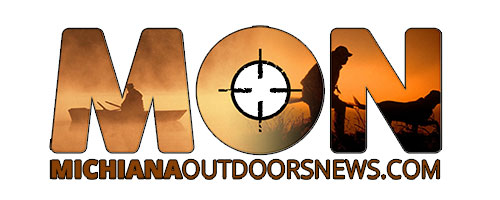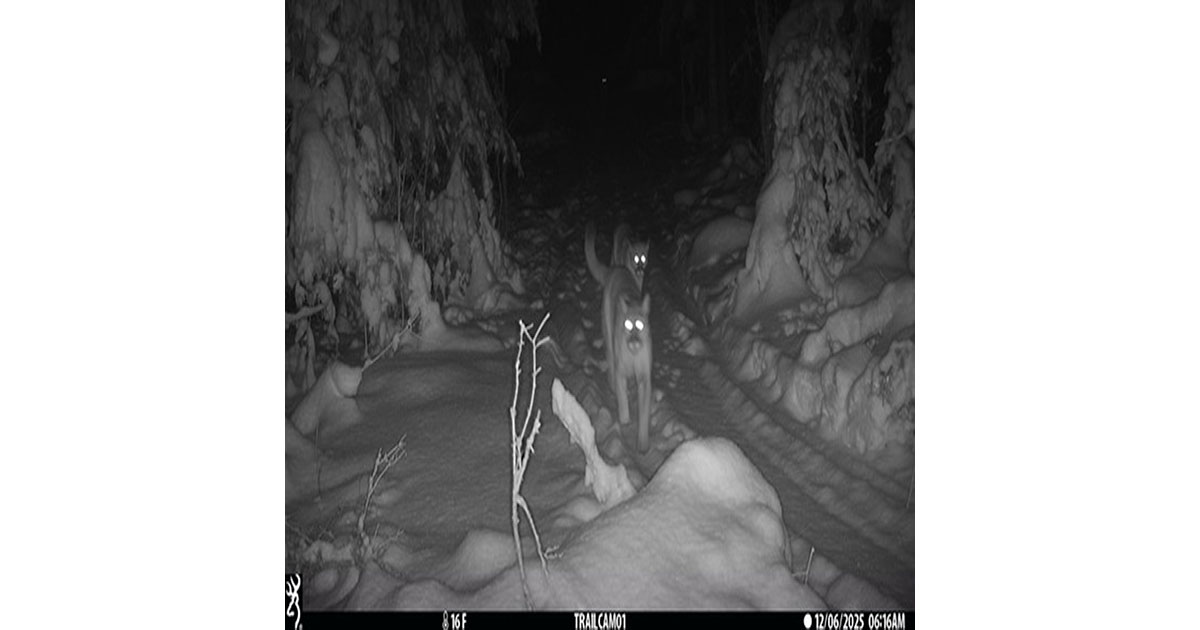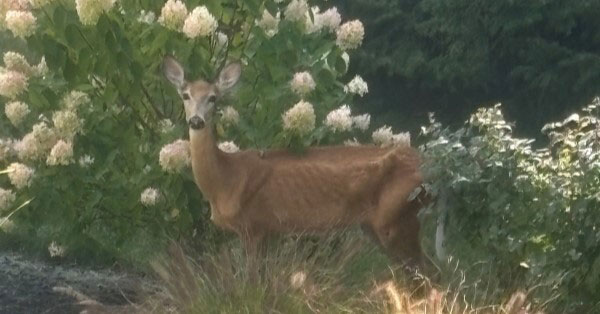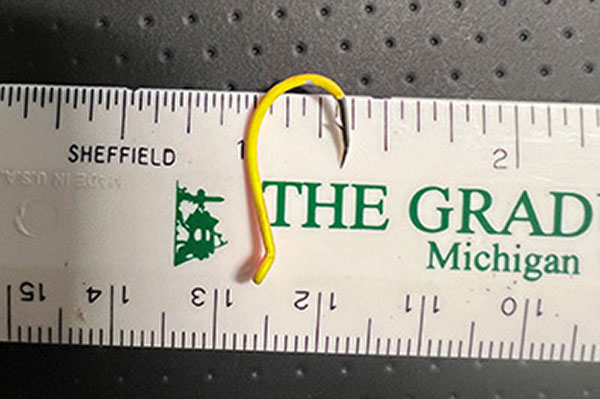
- Details
MDNR Report
Looking for a summer job?
Join the Michigan DNR’s dynamic team of 1,300 summer park workers and spend your season in Michigan state parks, boating facilities and other outdoor spaces!
You'll play a vital role in park operations, directly contributing to the visitor experience by welcoming guests, registering campers and ensuring the upkeep of our facilities through essential tasks like cleaning and grounds maintenance.
Beyond earning a starting hourly rate of $15.50, you'll connect with nature, meet incredible people and gain valuable skills in customer service, teamwork and outdoor recreation.
Apply now! It takes less than five minutes to complete the online interest form.
Express interest in a summer park worker position!

- Details
MDNR Report

Nine months after two cougar kittens were documented in the Upper Peninsula, a new trail camera photo indicates the elusive animals are still alive and living with their mother.
The Michigan DNR verified the Dec. 6 photo of an adult cougar being followed by two kittens down a snowy trail in central Ontonagon County. The last time the kittens were documented – in early March – they were only about two months old and their mother was nowhere in sight, raising concerns about the kittens’ survival.
But the newly verified photo shows an adult cougar with two juvenile cougars that appear to be about a year old, according to Brian Roell, the DNR’s large carnivore specialist.
Michigan is home to very few cougars and genetic testing has confirmed the existence of only adult males. The new photo suggests one of the first instances of cougar reproduction to take place outside the cougars’ core area in the Western states.
“This is a historic confirmation for Michigan since it is the first time in over 100 years that verified cougar reproduction has occurred east of the Mississippi River and possible even east of the Missouri River,” Roell said.
A private landowner sent the trail camera photo of the cougars to the DNR on Sunday, Dec. 14. Roell verified the site of the photo Monday and the DNR’s cougar team confirmed the photo Tuesday by enhancing the nighttime image to verify the existence of the three cougars. The sex of the kittens is unknown.
Cougar kittens, or cubs, generally stay with their mother for about two years before venturing out on their own.
“The kittens’ chances of survival are actually pretty high because just like bears, cougars invest a lot of their energy into their young,” Roell said. “So these kittens will stay with their mom through this winter and possibly even into next winter. They already have a leg up, seeing as how they’ve been with her for a year now.”
Roell is surprised the cougar kittens weren’t documented from any public or private trail cameras since March. The DNR operates more than 1,300 trail cameras in the U.P. to survey wildlife abundance.
“The interesting thing is, where were they for nine months?” Roell says. “That’s a mystery.”
Native to Michigan, cougars were essentially hunted out of the state by the early 1900s. Since 2008, the DNR has confirmed about 168 cougar sightings, all in the U.P., although most of those sightings are of the same animal being reported by multiple sources, Roell said.
Cougar sightings have increased each year since 2019, Roell added, but the number of trail cameras has also increased. Cougar sightings on DNR-operated cameras accounted for more than 25% of the verified cougar sightings in 2024. Visit the DNR’s cougar dashboard and cougar photo page for more information.
In addition to the cougar kittens in Michigan, there have been more cougars reported in other areas, including Nebraska. However, cougars need vast territories because they are solitary ambush predators that rely on deer and other large prey, which leads to low population densities. Even states with the largest cougar populations generally have just a few thousand of the animals.
“This isn’t an animal that is ever going to become very numerous,” Roell said. “They’re going to remain rare on the landscape regardless of whatever happens with them here in Michigan.”
Cougars are on the list of endangered mammals in Michigan, meaning it’s illegal to hunt or harass them, which includes trying to locate their den on public or private property.
“Too much human pressure can also trigger the female cougar to abandon her cubs,” Roell said. “As with all wild animals, we’re asking the public to respect their habitat and allow them to live naturally in their home.”
- Details
MDNR Report

Allegan is now the 17th Michigan county where chronic wasting disease has been identified in the wild deer population, according to the Michigan Department of Natural Resources. An emaciated doe reported by residents of Leighton Township recently tested positive for the disease.
CWD was confirmed by the Wisconsin Veterinary Diagnostic Laboratory. The sample was also sent for a secondary confirmation to the U.S. Department of Agriculture’s National Veterinary Services Laboratory in Ames, Iowa, but results may be delayed due to the federal government shutdown.
CWD is a fatal neurological disease that affects white-tailed deer, elk and moose. To date, the disease has also been detected in the following Michigan counties: Clinton, Dickinson, Eaton, Genesee, Gratiot, Hillsdale, Ingham, Ionia, Isabella, Jackson, Kent, Mecosta, Midland, Montcalm, Ogemaw and Washtenaw.
The declining health of this 1.5-year-old doe was first noted by private landowners in late summer. In late September, the DNR was contacted and authorized humane euthanasia and collection of the deer. On exam at the DNR’s Wildlife Disease Lab, the deer was noted to be in poor physical condition with no body fat.
“The care that’s demonstrated when people take the time to share their observations is a critical contribution to our disease-testing efforts,” said Brent Rudolph, DNR deer, elk and moose management specialist. “Public reporting of deer that appear unhealthy is very important for identifying CWD that may exist at low levels in previously undetected areas.”
CWD is a chronic, slow-developing disease that spreads slowly across the landscape. It has been detected in Kent County, adjacent to Leighton Township, which is in the northeast corner of Allegan County. Allegan County was under focused CWD surveillance in 2021, when approximately 500 deer were tested, with none testing positive. The DNR has continued to test deer that appear sick in Allegan County when possible. Hunters can get their deer tested with a free CWD self-sample submission kit from the DNR.
Deer that appear emaciated, lethargic, disoriented, lame or unresponsive are good candidates for CWD testing, though these symptoms are characteristic of deer affected by other maladies or injuries as well. The public is encouraged to report sick deer at Michigan.gov/EyesInTheField.
Safety recommendations
To date, there have been no reported cases of CWD infection in people. However, as a precaution, the U.S. Centers for Disease Control and Prevention recommends that infected animals not be consumed as food by either humans or domestic animals.
Hunters should take precautions when field-dressing or processing deer: wear rubber gloves, minimize contact with the deer’s brain and spinal tissue, and wash hands with soap and warm water after handling any parts of the carcass.
Proper disposal of deer carcasses is critical to prevent the spread of chronic wasting disease. Deer carcasses and parts should go directly to a landfill or be disposed of through regular bagged trash pickup. Studies show that CWD can survive on the landscape for years, contributing to the spread of disease. Deer harvested from known CWD areas should never be disposed of on the landscape.
Testing options for hunters
There are several testing options available to hunters, depending on their hunting location. In 2025, focused testing will continue in Baraga, Chippewa, Dickinson, Houghton, Iosco, Keweenaw, Luce, Mackinac, Ogemaw, Ontonagon and Schoolcraft counties in the Lower and Upper peninsulas. More information on CWD testing in these counties and a link to find DNR drop boxes and staffed sample submission sites are available on the CWD testing webpage.
Free self-sample submission kits have been available in limited areas for the last three years. Beginning in 2025, these kits are now available in all counties outside of the DNR bovine tuberculosis (bTB) or CWD surveillance areas. Kits allow hunters to remove lymph nodes and ship them directly to the MSU Veterinary Diagnostic Laboratory at no cost. Hunters can pick up a kit at a local distribution site. If hunters choose not to pick up a kit, testing is available for a fee through direct submission to a cooperating USDA-approved diagnostic laboratory.
All deer from counties with previous confirmed cases of CWD or bTB that are donated to the Hunters Feeding Michigan program are also submitted directly to the MSU lab for testing.
The DNR’s work with researchers and hunters to detect and slow the spread of CWD is possible because of limited general fund dollars allocated by the Michigan state legislature.
Michigan’s CWD testing strategy
Since chronic wasting disease was first detected in Michigan's wild deer in 2015, more than 110,000 deer in Michigan have been tested for CWD through a variety of efforts, including responding to public reports of sick deer and focused testing of hunter-harvested deer. In total, more than 144,000 wild deer have been tested through DNR surveillance efforts that started in 2002, with 265 CWD-positive deer identified. In addition, since direct hunter submissions of deer to the MSU lab began in 2020, more than 3,400 submitted samples have yielded 61 additional confirmed positives.
After initial intensive testing near areas of the first CWD detections in the state, the DNR began a rotational approach to testing harvested deer in 2021. A group of counties is selected each year, with the eventual aim of testing enough deer in every Michigan county. The goal of this approach is early disease detection, as management has the potential to be most effective when the disease is caught early. This method also provides confidence that if the disease does exist in these areas but goes undetected, that it is most likely there at a very low level.
For more information on chronic wasting disease, visit Michigan.gov/CWD.
- Details
MDNR Report
The Michigan DNR is alerting anglers that the ports of Grand Haven, Muskegon and Whitehall/Montague are covered by new regulations restricting allowable fishing gear at these locations from Nov. 1 to Nov. 30.
The goal of these regulation changes (approved by the Michigan Natural Resources Commission in Fisheries Order 202.25) is to protect spawning lake whitefish by reducing snagging, as well as overall harvest of adult lake whitefish in these areas.
Lake whitefish populations in Lake Michigan are in decline, due to pressures from invasive zebra and quagga mussels, which have altered the food web of the Great Lakes.
Based on angler creel survey data, much of the harvest of lake whitefish in these areas is from snagged fish. The new gear restrictions address snagging, which should reduce the overall harvest of lake whitefish.
“Lake whitefish numbers have been in decline in Lake Michigan since the late 1990s,” said Jay Wesley, the DNR’s Lake Michigan Basin coordinator. “Lowering harvest in November will help protect spawning adult lake whitefish while continuing to allow this unique angler opportunity."
If the new gear restrictions are not effective at reducing harvest, fisheries managers may consider recommending a lower daily possession limit of lake whitefish.
The locations under these regulations include the port of Muskegon from the westernmost pier head extending into Lake Michigan (excluding break walls) to the easternmost pier head extending into Muskegon Lake; the port of Whitehall/Montague from the westernmost pier head extending into Lake Michigan to the easternmost pier head extending into White Lake; and the port of Grand Haven from the westernmost pier head extending into Lake Michigan to the U.S. 31 bridge (northbound Beacon Boulevard).

At these ports, it is unlawful to use other than one single-pointed unweighted hook measuring a half-inch or less from point to shank from Nov. 1 to Nov. 30 (see pp. 30-31 of the 2025 Michigan Fishing Regulations). Plus, on these same waters, it is unlawful to spear or possess spearing gear from Nov. 1 to Nov. 30 (see pp. 16-17 of the 2025 Michigan Fishing Regulations).

Only single-pointed, unweighted hooks are allowed under these regulations. Single hooks cannot be molded or permanently fixed to a weight or weighted lure. The use of jigs on these waters is prohibited, since they are weighted (metal is molded onto the hook). Lures fished with one single-pointed, unweighted hook would be allowable.
Review the 2025 Michigan Fishing Regulations in the Michigan DNR Hunt Fish app or at Michigan.gov/DNRRegs. To obtain a physical copy of the regulations, reach out to your local DNR Customer Service Center or email MDNR-E-License@Michigan.gov.
Learn more about lake whitefish at Michigan.gov/DNR/Education/Michigan-Species/Fish-Species/Whitefish.
- Details
MDNR Report

When you think of reefs, the Great Lakes don’t immediately come to mind; instead, most people picture the coral reefs associated with tropical waters and colorful fish. But Saginaw Bay once had many rock reefs, created by glacial activity, that provided an important type of habitat for the bay’s aquatic species. Over time, reef habitat was lost, buried by sediment due to logging, manufacturing and agricultural activity in the area. To restore this lost reef habitat, the DNR and many partner organizations worked together on a portfolio of reef habitat projects, including the recently completed Channel Island Reef.
A nearshore reef, Channel Island Reef is constructed in the bay near Channel Island (aka Spoils Island). It is made of natural rock that rises several feet from the bottom but still sits a few feet below the surface of the water. Locally sourced limestone was used, which creates crevices and ledges perfect for spawning fish to deposit eggs into and for young fry (newly hatched fish) to hide from predators. The reef will get lots of wave action, which will keep sediment from building up and wash oxygenated water over fertilized fish eggs, increasing their survival.
“Restoring rocky reefs can help make native fish species – like lake whitefish and walleye – more resilient,” said Jeff Jolley, the DNR’s Southern Lake Huron Fisheries Management Unit manager.
These species use reef habitat for spawning, making it essential for supporting strong fish populations, especially whitefish, which are in decline elsewhere in the Great Lakes.
Jolley said that while walleye are now thriving in the bay, much of the population currently relies on river spawning. That makes it vulnerable—if just one or two river systems experience a disaster, blockage or habitat decline, the effects could ripple across the entire population. By restoring and enhancing diverse spawning habitats, biologists aim to build resiliency into the population.
“It’s similar to diversifying an investment portfolio,” said Jolley. “Spreading the ‘risk’ across multiple spawning areas helps ensure the walleye population remains strong even if one site falters.”
In the coming years, fisheries biologists will study activity at the reef, learning more about how fish use the reef and its beneficial effects on the ecology of Saginaw Bay.
Learn more about the project: Channel Island Reef: Increasing fish spawning habitat and resilience in Saginaw Bay | Michigan Sea Grant.


